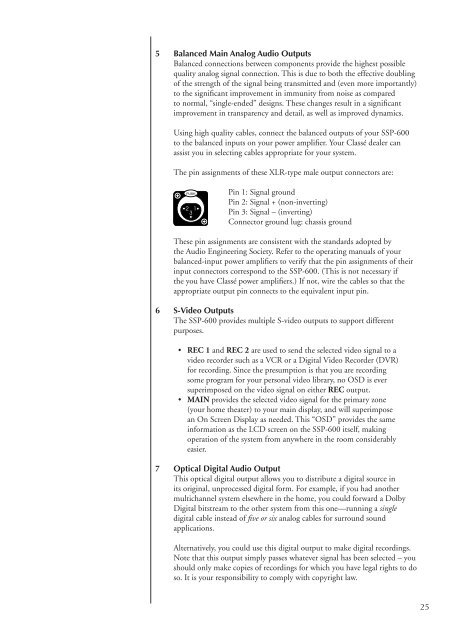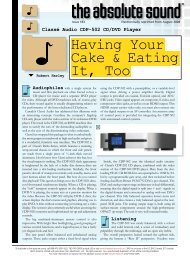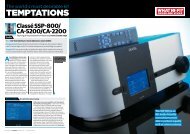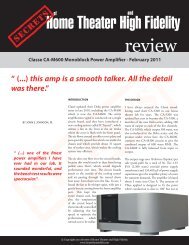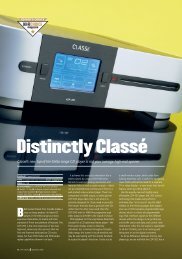Owner's Manual SSP-600 Surround Processor - Classé Audio
Owner's Manual SSP-600 Surround Processor - Classé Audio
Owner's Manual SSP-600 Surround Processor - Classé Audio
Create successful ePaper yourself
Turn your PDF publications into a flip-book with our unique Google optimized e-Paper software.
5 Balanced Main Analog <strong>Audio</strong> Outputs<br />
Balanced connections between components provide the highest possible<br />
quality analog signal connection. This is due to both the effective doubling<br />
of the strength of the signal being transmitted and (even more importantly)<br />
to the significant improvement in immunity from noise as compared<br />
to normal, “single-ended” designs. These changes result in a significant<br />
improvement in transparency and detail, as well as improved dynamics.<br />
Using high quality cables, connect the balanced outputs of your <strong>SSP</strong>-<strong>600</strong><br />
to the balanced inputs on your power amplifier. Your Classé dealer can<br />
assist you in selecting cables appropriate for your system.<br />
The pin assignments of these XLR-type male output connectors are:<br />
Pin 1: Signal ground<br />
Pin 2: Signal + (non-inverting)<br />
Pin 3: Signal – (inverting)<br />
Connector ground lug: chassis ground<br />
These pin assignments are consistent with the standards adopted by<br />
the <strong>Audio</strong> Engineering Society. Refer to the operating manuals of your<br />
balanced-input power amplifiers to verify that the pin assignments of their<br />
input connectors correspond to the <strong>SSP</strong>-<strong>600</strong>. (This is not necessary if<br />
the you have Classé power amplifiers.) If not, wire the cables so that the<br />
appropriate output pin connects to the equivalent input pin.<br />
6 S-Video Outputs<br />
The <strong>SSP</strong>-<strong>600</strong> provides multiple S-video outputs to support different<br />
purposes.<br />
• REC 1 and REC 2 are used to send the selected video signal to a<br />
video recorder such as a VCR or a Digital Video Recorder (DVR)<br />
for recording. Since the presumption is that you are recording<br />
some program for your personal video library, no OSD is ever<br />
superimposed on the video signal on either REC output.<br />
• MAIN provides the selected video signal for the primary zone<br />
(your home theater) to your main display, and will superimpose<br />
an On Screen Display as needed. This “OSD” provides the same<br />
information as the LCD screen on the <strong>SSP</strong>-<strong>600</strong> itself, making<br />
operation of the system from anywhere in the room considerably<br />
easier.<br />
7 Optical Digital <strong>Audio</strong> Output<br />
This optical digital output allows you to distribute a digital source in<br />
its original, unprocessed digital form. For example, if you had another<br />
multichannel system elsewhere in the home, you could forward a Dolby<br />
Digital bitstream to the other system from this one—running a single<br />
digital cable instead of five or six analog cables for surround sound<br />
applications.<br />
Alternatively, you could use this digital output to make digital recordings.<br />
Note that this output simply passes whatever signal has been selected – you<br />
should only make copies of recordings for which you have legal rights to do<br />
so. It is your responsibility to comply with copyright law.<br />
25


